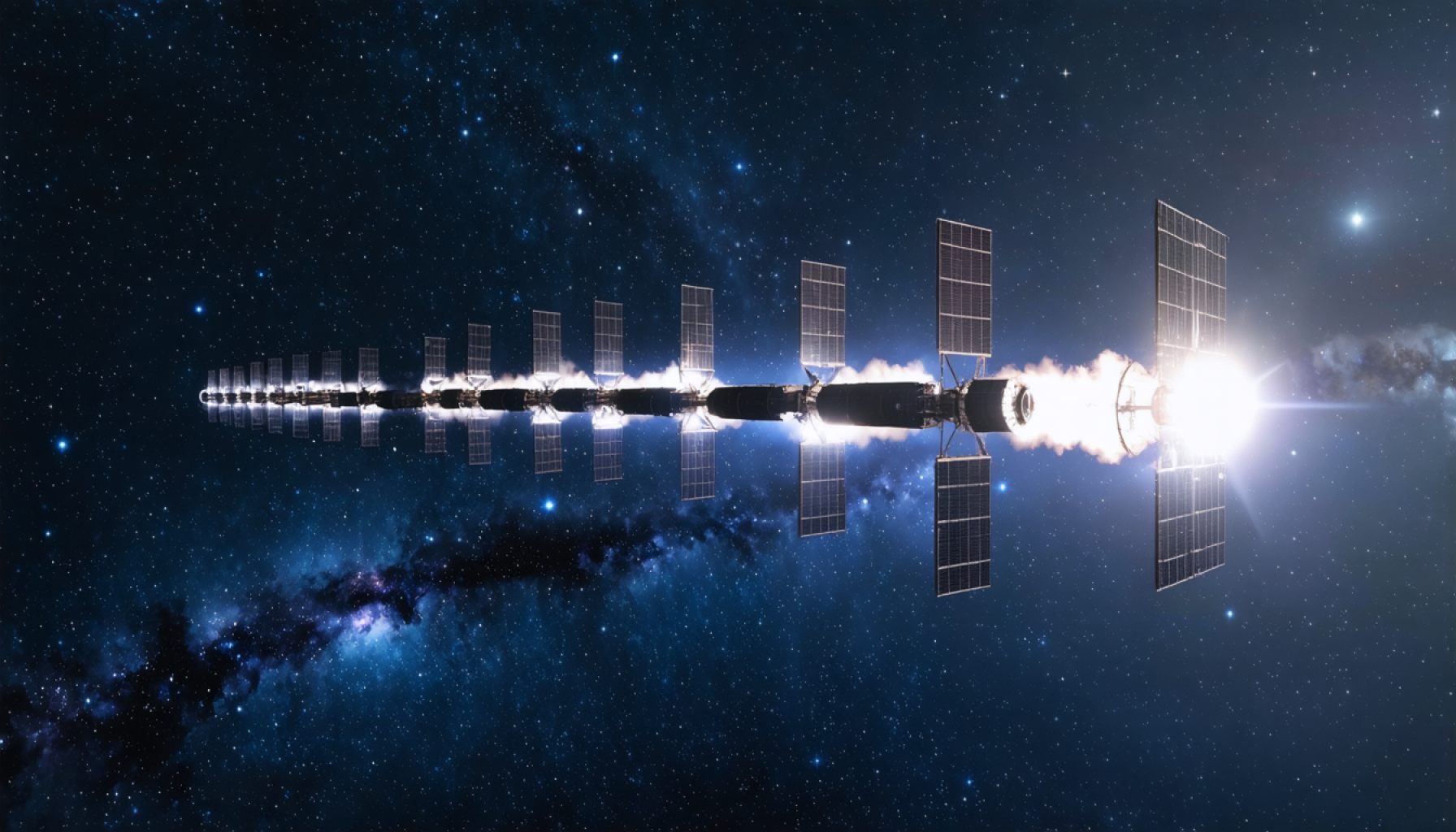- SpaceX is set to launch a Falcon 9 rocket from NASA Kennedy Space Center at 1:24 a.m., aiming to enhance global internet connectivity with 21 new Starlink satellites.
- Over half of these satellites are equipped with innovative direct-to-cell capabilities, promising to connect underserved regions to the digital grid.
- The mission demonstrates SpaceX’s commitment to reducing space exploration costs through reusable rocket technology, as the Falcon 9 booster will land on a droneship in the Atlantic Ocean.
- The launch highlights humanity’s relentless pursuit of progress and the transformative potential of advanced space technology.
- This mission serves as a significant step towards an interconnected world and showcases the possibilities when pioneering visions are supported by groundbreaking technology.
Another dawn over Florida’s eastern horizon is set to witness a spectacle of fiery ambition, as SpaceX propels humanity one step closer to an interconnected world. As the clock ticks toward 1:24 a.m. at the revered NASA Kennedy Space Center, the sky will crackle and blaze, heralding the launch of the Falcon 9 rocket. Aboard are 21 pristine Starlink satellites, with over half primed for a groundbreaking leap forward—direct-to-cell capabilities.
The silvery streak of the Falcon 9 aims to expand SpaceX’s audacious global web of high-speed internet, weaving a seamless net of connectivity across the planet. These satellites, nestled in the protective embrace of the rocket’s payload—and soon to grace the firmament at low Earth orbit—are the latest warriors in Elon Musk’s celestial campaign. With them, billions of underserved corners of the globe draw nearer to the rest of us, promising a spark of digital connection where isolation once reigned.
But technical finesse is not all that captivates this mission. Once the beacon ascends, SpaceX orchestrates another marvel—a mid-sea ballet of engineering prowess. Following stage separation, the rocket’s booster will gracefully descend to its floating haven, a droneship in the vast Atlantic. It’s a testament to remarkable reusability, a bold step in reducing the cost of space exploration and nurturing the dream of accessibility beyond Earth’s atmosphere.
Such missions capture the imagination; they render the abstract tangible, showcasing humanity’s relentless pursuit of progress. We stand on the cusp of a new era, driven by pioneers who view the sky not as a limit, but as an invitation.
And so, as the countdown concludes and engines roar into the night, mankind watches not just another rocket launch. We witness a keystone in the legacy of exploration—a testament to what’s possible when dreams are backed by daring technology. Whether gazing up from the coastal sands or peeking through the glow of a smartphone screen, we find ourselves collectively inspired, our eyes set firmly on the stars.
How SpaceX’s Latest Starlink Launch is Transforming Global Connectivity
Key Insights from the SpaceX Starlink Launch
The recent SpaceX Falcon 9 launch from NASA’s Kennedy Space Center was more than just a breathtaking spectacle; it marked a pivotal moment in advancing global internet connectivity. This launch carried 21 new Starlink satellites, some of which are equipped with direct-to-cell capabilities, revolutionizing the way we think about communication and connectivity.
How-To Steps & Life Hacks
1. Stay Connected Anywhere: As Starlink satellites continue to expand their coverage, rural and remote areas will experience improved internet access. To leverage this, consider subscribing to Starlink services, especially if you’re in regions traditionally underserved by internet providers.
2. Optimize Your Connectivity: If you’re already a Starlink user, ensure your dish is correctly positioned with a clear view of the sky to maximize signal reception. Regular updates from the Starlink app can help maintain optimal performance.
3. Manage Data Usage: With satellite internet, managing data effectively is crucial. Opt for streaming in standard definition when possible and schedule large downloads during off-peak hours if your plan has data limits.
Real-World Use Cases
– Emergency Services: Starlink’s direct-to-cell capabilities could revolutionize emergency response services in disaster-hit areas by providing real-time communication without relying on damaged infrastructure.
– Rural Education: Schools in remote areas can harness high-speed internet for online learning, bridging educational gaps and opening access to global resources.
Market Forecasts & Industry Trends
The satellite internet market is anticipated to witness significant growth, with SpaceX and competitors like OneWeb and Amazon’s Project Kuiper vying for dominance. The global satellite communication market is projected to reach over $50 billion by 2027, driven by advancements in technology and increased demand for connectivity (source: Allied Market Research).
Features, Specs & Pricing
– Direct-to-Cell Satellites: The new Starlink satellites are equipped with advanced antennas and transmitters capable of connecting directly to cellular devices, bypassing traditional cellular networks.
– Pricing: While SpaceX continues to refine pricing models, it’s expected that Starlink’s accessibility and performance will justify its cost, especially in regions where conventional broadband is expensive or unreliable.
Security & Sustainability
SpaceX is committed to reducing space debris, and these satellites are designed for efficient deployment and deorbiting after their service life. This aligns with global initiatives to maintain a sustainable space environment.
Insights & Predictions
Looking ahead, SpaceX’s ambitious plans include linking Starlink satellites with other technologies on the International Space Station (ISS) and collaborating with Google Cloud to enhance data transfer capabilities. This synergy between terrestrial and space-based connectivity will likely accelerate the adoption of IoT devices and smart technologies.
Actionable Recommendations
– Explore Subscription Plans: Consider SpaceX’s Starlink for rural high-speed internet needs. Evaluate the coverage map and availability in your area.
– Monitor Technological Updates: Stay informed on SpaceX’s advancements, particularly regarding compatibility with direct-to-cell services, enhancing how you use mobile devices for internet access.
– Advocate for Deployment: Encourage local governments and businesses to invest in satellite technology for broader community benefits, particularly in education and emergency response.
For more information about SpaceX and its Starlink program, head to SpaceX’s official website.
As we continue to break traditional barriers in connectivity, the sky is not the limit—it’s just the beginning.
